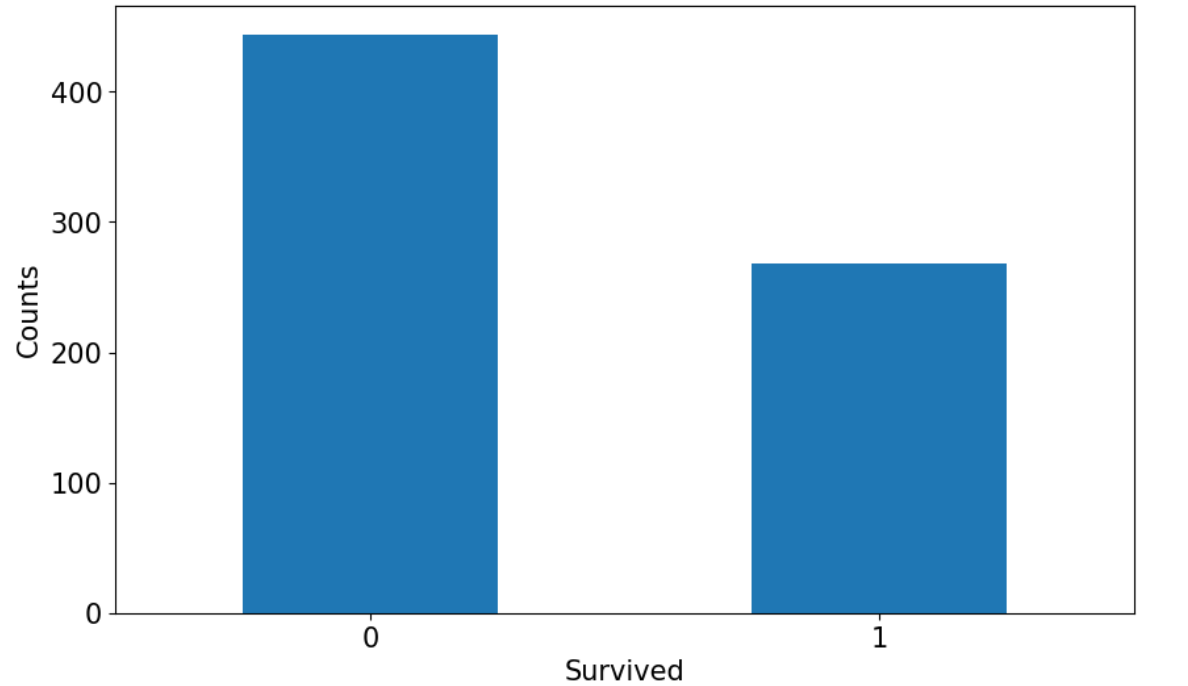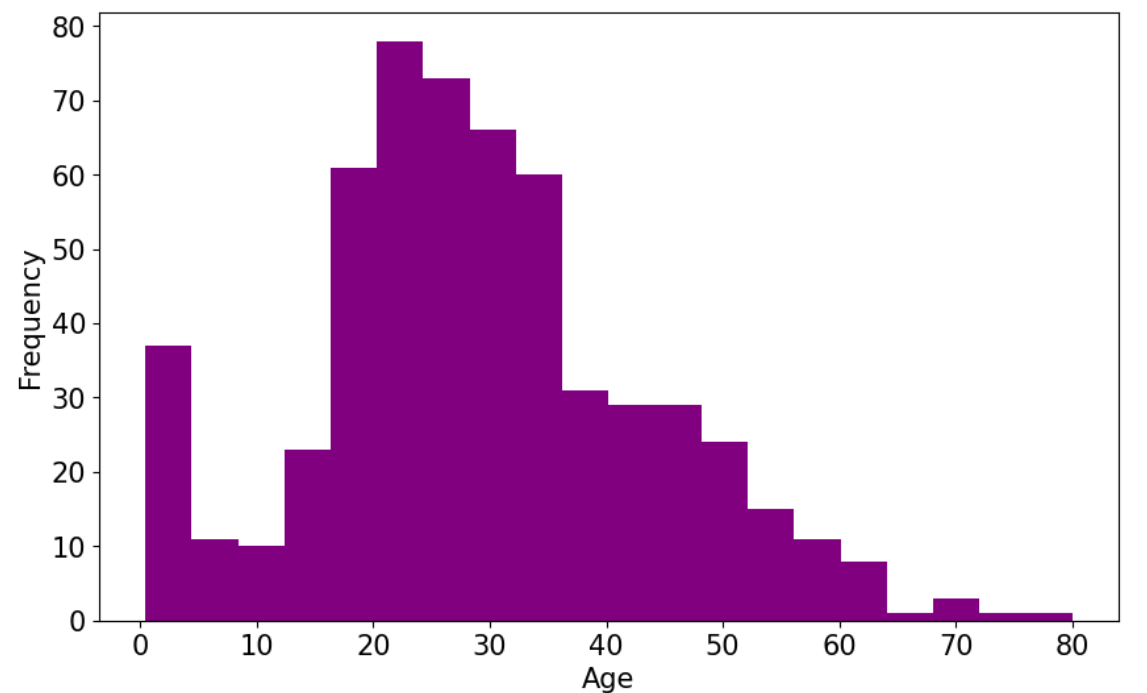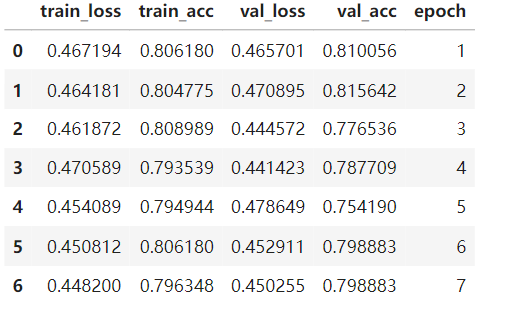0.环境配置
import os
#mac系统上pytorch和matplotlib在jupyter中同时跑需要更改环境变量
# os.environ["KMP_DUPLICATE_LIB_OK"]="TRUE"
!pip install -U torchkeras -i https://pypi.douban.com/simple
!pip install pandas -i https://pypi.douban.com/simple
!pip install matplotlib -i https://pypi.douban.com/simple
!pip install scikit-learn -i https://pypi.douban.com/simple
import torch
import torchkeras
print(torch.__version__)
"""
2.1.0+cpu
"""
print(torchkeras.__version__)
"""
3.9.4
"""
1.准备数据
import numpy as np
import pandas as pd
import matplotlib.pyplot as plt
from sklearn.model_selection import train_test_split
df_train_raw = pd.read_csv('dataset/titanic/train.csv')
df_train_raw, df_test_raw = train_test_split(df_train_raw, test_size=0.2, random_state=42)
df_train_raw.head()

字段说明:
- Survived:0代表死亡,1代表存活【y标签】
- Pclass:乘客所持票类,有三种值(1,2,3) 【转换成onehot编码】
- Name:乘客姓名 【舍去】
- Sex:乘客性别 【转换成bool特征】
- Age:乘客年龄(有缺失) 【数值特征,添加“年龄是否缺失”作为辅助特征】
- SibSp:乘客兄弟姐妹/配偶的个数(整数值) 【数值特征】
- Parch:乘客父母/孩子的个数(整数值)【数值特征】
- Ticket:票号(字符串)【舍去】
- Fare:乘客所持票的价格(浮点数,0-500不等) 【数值特征】
- Cabin:乘客所在船舱(有缺失) 【添加“所在船舱是否缺失”作为辅助特征】
- Embarked:乘客登船港口:S、C、Q(有缺失)【转换成onehot编码,四维度 S,C,Q,nan】 S,C,Q,nan】
%matplotlib inline
%config InlineBackend.figure_format = 'png'
ax = df_train_raw['Survived'].value_counts().plot(kind = 'bar',
figsize = (12,8),fontsize=15,rot = 0)
ax.set_ylabel('Counts',fontsize = 15)
ax.set_xlabel('Survived',fontsize = 15)
plt.show()

%matplotlib inline
%config InlineBackend.figure_format = 'png'
ax = df_train_raw['Age'].plot(kind = 'hist',bins = 20,color= 'purple',
figsize = (10,6),fontsize=15)
ax.set_ylabel('Frequency',fontsize = 15)
ax.set_xlabel('Age',fontsize = 15)
plt.show()

%matplotlib inline
%config InlineBackend.figure_format = 'png'
ax = df_train_raw.query('Survived == 0')['Age'].plot(kind = 'density',
figsize = (10,6),fontsize=15)
df_train_raw.query('Survived == 1')['Age'].plot(kind = 'density',
figsize = (10,6),fontsize=15)
ax.legend(['Survived==0','Survived==1'],fontsize = 12)
ax.set_ylabel('Density',fontsize = 15)
ax.set_xlabel('Age',fontsize = 15)
plt.show()

def preprocessing(dfdata):
dfresult= pd.DataFrame()
#Pclass
dfPclass = pd.get_dummies(dfdata['Pclass'], dtype='int32')
dfPclass.columns = ['Pclass_' +str(x) for x in dfPclass.columns ]
dfresult = pd.concat([dfresult,dfPclass],axis = 1)
#Sex
dfSex = pd.get_dummies(dfdata['Sex'], dtype='int32')
dfresult = pd.concat([dfresult,dfSex],axis = 1)
#Age
dfresult['Age'] = dfdata['Age'].fillna(0)
dfresult['Age_null'] = pd.isna(dfdata['Age']).astype('int32')
#SibSp,Parch,Fare
dfresult['SibSp'] = dfdata['SibSp']
dfresult['Parch'] = dfdata['Parch']
dfresult['Fare'] = dfdata['Fare']
#Carbin
dfresult['Cabin_null'] = pd.isna(dfdata['Cabin']).astype('int32')
#Embarked
dfEmbarked = pd.get_dummies(dfdata['Embarked'], dummy_na=True, dtype='int32')
dfEmbarked.columns = ['Embarked_' + str(x) for x in dfEmbarked.columns]
dfresult = pd.concat([dfresult,dfEmbarked],axis = 1)
return dfresult
x_train = preprocessing(df_train_raw).values
y_train = df_train_raw[['Survived']].values
x_test = preprocessing(df_test_raw).values
y_test = df_test_raw[['Survived']].values
print("x_train.shape =", x_train.shape )
print("x_test.shape =", x_test.shape )
print("y_train.shape =", y_train.shape )
print("y_test.shape =", y_test.shape )
"""
x_train.shape = (712, 15)
x_test.shape = (179, 15)
y_train.shape = (712, 1)
y_test.shape = (179, 1)
"""
# 使用DataLoader和TensorDataset封装成可以迭代的数据管道
dl_train = torch.utils.data.DataLoader(torch.utils.data.TensorDataset(torch.tensor(x_train).float(), torch.tensor(y_train).float()), shuffle=True, batch_size=8)
dl_val = torch.utils.data.DataLoader(torch.utils.data.TensorDataset(torch.tensor(x_test).float(),torch.tensor(y_test).float()), shuffle = False, batch_size = 8)
# 测试数据管道
for features, labels in dl_train:
print(features, labels)
break
"""
tensor([[ 0.0000, 0.0000, 1.0000, 1.0000, 0.0000, 0.7500, 0.0000,
2.0000, 1.0000, 19.2583, 1.0000, 1.0000, 0.0000, 0.0000,
0.0000],
[ 0.0000, 0.0000, 1.0000, 0.0000, 1.0000, 32.0000, 0.0000,
0.0000, 0.0000, 7.9250, 1.0000, 0.0000, 0.0000, 1.0000,
0.0000],
[ 0.0000, 1.0000, 0.0000, 1.0000, 0.0000, 2.0000, 0.0000,
1.0000, 1.0000, 26.0000, 1.0000, 0.0000, 0.0000, 1.0000,
0.0000],
[ 0.0000, 0.0000, 1.0000, 1.0000, 0.0000, 18.0000, 0.0000,
0.0000, 0.0000, 6.7500, 1.0000, 0.0000, 1.0000, 0.0000,
0.0000],
[ 0.0000, 0.0000, 1.0000, 0.0000, 1.0000, 25.0000, 0.0000,
0.0000, 0.0000, 7.0500, 1.0000, 0.0000, 0.0000, 1.0000,
0.0000],
[ 0.0000, 0.0000, 1.0000, 0.0000, 1.0000, 22.0000, 0.0000,
0.0000, 0.0000, 7.1250, 1.0000, 0.0000, 0.0000, 1.0000,
0.0000],
[ 0.0000, 0.0000, 1.0000, 0.0000, 1.0000, 22.0000, 0.0000,
0.0000, 0.0000, 7.2292, 1.0000, 1.0000, 0.0000, 0.0000,
0.0000],
[ 1.0000, 0.0000, 0.0000, 1.0000, 0.0000, 0.0000, 1.0000,
1.0000, 0.0000, 133.6500, 1.0000, 0.0000, 0.0000, 1.0000,
0.0000]]) tensor([[1.],
[0.],
[1.],
[0.],
[0.],
[0.],
[0.],
[1.]])
"""
2.定义模型
使用Pytorch通常有三种方式构建模型:使用nn.Sequential按层顺序构建模型,继承nn.Module基类构建自定义模型,继承nn.Module基类构建模型并辅助应用模型容器进行封装。 此处选择使用最简单的nn.Sequential按层顺序构建模型
def create_net():
net = torch.nn.Sequential()
net.add_module('linear1', torch.nn.Linear(15, 20))
net.add_module('relu1', torch.nn.ReLU())
net.add_module('linear2', torch.nn.Linear(20, 15))
net.add_module('relu2', torch.nn.ReLU())
net.add_module('linear3', torch.nn.Linear(15, 1))
return net
net = create_net()
print(net)
"""
Sequential(
(linear1): Linear(in_features=15, out_features=20, bias=True)
(relu1): ReLU()
(linear2): Linear(in_features=20, out_features=15, bias=True)
(relu2): ReLU()
(linear3): Linear(in_features=15, out_features=1, bias=True)
)
"""
3.训练模型
Pytorch通常需要用户编写自定义训练循环,训练循环的代码风格因人而已。 有3类典型的训练循环代码风格:脚本式训练循环,函数式训练循环,类形式训练循环。 此处介绍一种较通用的仿照Keras风格的脚本式训练循环。 该脚本式训练代码与torchkeras库的核心代码基本一致。 torchkeras详情: https://github.com/lyhue1991/torchkeras
import os
import sys
import time
import numpy as np
import datetime
from tqdm import tqdm
import torch
from copy import deepcopy
from torchkeras.metrics import Accuracy
def printlog(info):
nowtime = datetime.datetime.now().strftime('%Y-%m-%d %H:%M:%S')
print('\n' + '=============' * 8 + "%s" % nowtime)
print(str(info) + '\n')
loss_fn = torch.nn.BCEWithLogitsLoss()
optimizer = torch.optim.Adam(net.parameters(), lr=0.01)
metric_dict = {"acc": Accuracy()}
epochs = 20
ckpt_path = 'checkpoint.pt'
# early_stopping相关设置
monitor = 'val_acc'
patience = 5
mode = 'max'
history = {}
for epoch in range(1, epochs + 1):
printlog('Epoch {} / {}'.format(epoch, epochs))
# train
net.train()
total_loss, step = 0, 0
loop = tqdm(enumerate(dl_train), total=len(dl_train), file=sys.stdout)
train_metrics_dict = deepcopy(metric_dict)
for i, batch in loop:
features, labels = batch
# forward
preds = net(features)
loss = loss_fn(preds, labels)
# backward
loss.backward()
optimizer.step()
optimizer.zero_grad()
# metrics
step_metrics = {'train_'+name: metric_fn(preds, labels).item() for name, metric_fn in train_metrics_dict.items()}
step_log = dict({'train_loss': loss.item()}, **step_metrics)
total_loss += loss.item()
step += 1
if i != len(dl_train) -1:
loop.set_postfix(**step_log)
else:
epoch_loss = total_loss / step
epoch_metrics = {'train_'+name: metric_fn.compute().item() for name, metric_fn in train_metrics_dict.items()}
epoch_log = dict({'train_loss': epoch_loss}, **epoch_metrics)
loop.set_postfix(**epoch_log)
for name, metric_fn in train_metrics_dict.items():
metric_fn.reset()
for name, metric in epoch_log.items():
history[name] = history.get(name, []) + [metric]
# validate
net.eval() # 不启用Batchnormalization Dropout
total_loss, step = 0, 0
loop = tqdm(enumerate(dl_val), total=len(dl_val), file=sys.stdout)
val_metrics_dict = deepcopy(metric_dict)
with torch.no_grad():
for i, batch in loop:
features, labels = batch
# forward
preds = net(features)
loss = loss_fn(preds, labels)
# metrics
step_metrics = {'val_' + name: metric_fn(preds, labels).item() for
name, metric_fn in val_metrics_dict.items()}
step_log = dict({'val_loss': loss.item()}, **step_metrics)
total_loss += loss.item()
step += 1
if i != len(dl_val) - 1:
loop.set_postfix(**step_log)
else:
epoch_loss = total_loss / step
epoch_metrics = {'val_'+name: metric_fn.compute().item() for
name, metric_fn in val_metrics_dict.items()}
epoch_log = dict({'val_loss': epoch_loss}, **epoch_metrics)
loop.set_postfix(**epoch_log)
for name, metric_fn in val_metrics_dict.items():
metric_fn.reset()
epoch_log['epoch'] = epoch
for name, metric in epoch_log.items():
history[name] = history.get(name, []) + [metric]
# early-stopping
arr_scores = history[monitor]
best_score_idx = np.argmax(arr_scores) if mode == 'max' else np.argmin(arr_scores)
if best_score_idx == len(arr_scores) - 1:
torch.save(net.state_dict(), ckpt_path)
print('<<<<<< reach best {0}: {1} >>>>>>'.format(monitor, arr_scores[best_score_idx]), file=sys.stderr)
if len(arr_scores) - best_score_idx > patience:
print('<<<<<< {} without improvement in {} epoch, early stopping >>>>>>'.format(monitor, patience), file=sys.stderr)
break
net.load_state_dict(torch.load(ckpt_path))
dfhistory = pd.DataFrame(history)
4.评估模型
dfhistory

%matplotlib inline
%config InlineBackend.figure_format = 'svg'
import matplotlib.pyplot as plt
def plot_metric(dfhistory, metric):
train_metrics = dfhistory['train_' + metric]
val_metrics = dfhistory['val_' + metric]
epochs = range(1, len(train_metrics) + 1)
plt.plot(epochs, train_metrics, 'bo--')
plt.plot(epochs, val_metrics, 'ro-')
plt.title('Trainning and validation ' + metric)
plt.xlabel('Epochs')
plt.ylabel(metric)
plt.legend(['train_' + metric, 'val_' + metric])
plt.show()
plot_metric(dfhistory, 'loss')

plot_metric(dfhistory, 'acc')

5.使用模型
# 预测概率
y_pred_probs = torch.sigmoid(net(torch.tensor(x_test[:10]).float())).data
y_pred_probs
"""
tensor([[0.1531],
[0.2011],
[0.1568],
[0.9407],
[0.7285],
[0.9579],
[0.7373],
[0.1192],
[0.7950],
[0.9357]])
"""
# 预测类别
y_pred = torch.where(y_pred_probs > 0.5, torch.ones_like(y_pred_probs), torch.zeros_like(y_pred_probs))
y_pred
"""
tensor([[0.],
[0.],
[0.],
[1.],
[1.],
[1.],
[1.],
[0.],
[1.],
[1.]])
"""
6.保存模型
- Pytorch有两种保存模型的方式,都是通过调用pickle序列化的方法实现的。
- 第一种方法只保存模型参数。
- 第二种方法保存完整模型
- 推荐使用第一种,第二种方法可能在切换设备和目录的时候出现各种问题
print(net.state_dict().keys())
"""
odict_keys(['linear1.weight', 'linear1.bias', 'linear2.weight', 'linear2.bias', 'linear3.weight', 'linear3.bias'])
"""
# 保存模型参数
torch.save(net.state_dict(), './data/net_parameters.pt')
net_clone = create_net()
net_clone.load_state_dict(torch.load('./data/net_parameters.pt'))
torch.sigmoid(net_clone(torch.tensor(x_test[:10]).float())).data
"""
tensor([[0.1531],
[0.2011],
[0.1568],
[0.9407],
[0.7285],
[0.9579],
[0.7373],
[0.1192],
[0.7950],
[0.9357]])
"""
# 保存完整模型
torch.save(net, './data/net_model.pt')
net_loaded = torch.load('./data/net_model.pt')
torch.sigmoid(net_loaded(torch.tensor(x_test[:10]).float())).data
"""
tensor([[0.1531],
[0.2011],
[0.1568],
[0.9407],
[0.7285],
[0.9579],
[0.7373],
[0.1192],
[0.7950],
[0.9357]])
"""